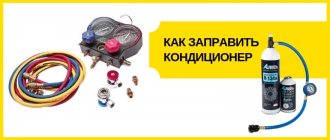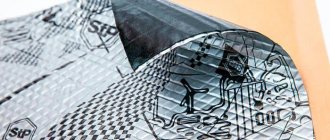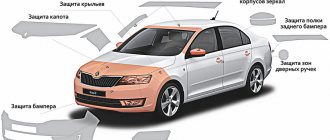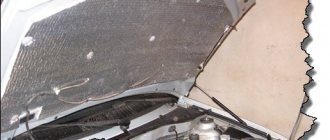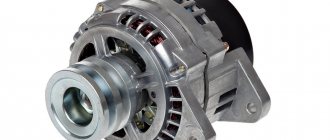Installation
Before installation, you need to take into account that you will have to work with an electrician, so evaluate your capabilities. If possible, consult or ask for help from a more experienced person. Installation is done as follows:
- Disconnect the battery, this will avoid a short circuit. Remove the negative wire;
- A place for the button is selected, and holes for its fastening are drilled in this place. Usually you need to drill 2-3 holes;
- Next there are 2 options. The first is to use the wire already on the battery, but in this case, you will have to carefully select the location of the button. The second option uses a new wire. A terminal is attached to it. On the other side, a crimp connector is installed. With this method, you can install the switch in any convenient place;
- We take the wire and crimp it on both sides into the mounting connectors;
- We install the button in its proper place;
- Connect the wires to the button. The wire from the terminal is connected to “-B”;
- The next step is to screw the second free wire to ground.
After that, all that remains is to check the operation of the button.
One comment
I didn’t understand how to turn off the mass and...!? Where is the explanation for turning off the mass. Didn't you go to school at all? A thyristor is not a simple switch! You can turn off the thyristor only: 1. apply a pulse to the control electrode; 2. close the current flow circuit; 3.apply current in the opposite direction. Please explain how you are going to disconnect the on-board circuit!? In what new, acceptable way for this case!? A thyristor is an uncontrolled device compared to a transistor!
To improve the safety of their vehicle, drivers install a battery disconnect switch. It can be purchased at a specialized store, or you can make it yourself. The article provides general information about the device and instructions for its manufacture.
Pay attention to technological nuances
A good switch is equipped with fuses and serves to de-energize the car battery. It is this circumstance that poses an additional problem for potential hijackers. If you decide to purchase a power switch, make sure it is new. Don't use a used one! In this state, the VM will easily damage the electrical system of the machine.
When the battery is de-energized, there is a high probability that the car computer will turn off. This, in turn, threatens failures, such as erasing from memory information necessary for full operation. How to prevent such a development of events, what energy source to buy and how to connect it - these issues should be discussed with professionals.
Progress
So, you purchased a ground switch for a VAZ car. Now it’s just a matter of small things – the connection process. To do this, prepare a workplace and the necessary tools:
Disconnecting the terminal from the battery ground. This will prevent a short circuit, which can cause not only a burnout of the car's electrical system, but even an electric shock. The operation is not difficult, since the terminal wire is painted black and marked with a minus sign.
Disconnection from the positive terminal of the battery. The wire of this terminal is red and marked with a “+” sign.
Disconnection is carried out carefully. At the same time, the level of the electrolyte fluid of the battery is checked and its terminals, both positive and negative, are cleaned with a brush. The ground terminal is retained - it will be needed when the car returns to active use.
Work directly with the switch. This unit is connected to the negative terminal of the battery using a key of the appropriate size. After tightening, you must make sure that the fastening is secure. The wiring terminal, in turn, is connected to the positive terminal of the battery, and the switch is connected to the ground wire.
Manufacturing Guide
For self-production, there is a simple VMA circuit without mechanical contacts, which ensures its reliability. An additional advantage of this design is the ability to use the device as an anti-theft device. The design of the device includes two conductors: a diode and a thyristor.
Scheme of a simple VMA
In this device, the thyristor is used as an electronic relay, which operates as soon as pulses appear on the control electrode. S1 is installed in a secret place in the car interior, and when the contacts are closed, the necessary impulse occurs. When a pulse arrives at the thyristor, it is unlocked, the resistance decreases sharply and a high voltage current flows through the network.
Thanks to the SCR, current flows only in the direction from the battery to the network.
Parts for main switch
To be able to recharge the battery from the generator, a diode is connected in parallel with the thyristor. The parts are attached to a duralumin corner. On one shelf, holes are drilled and semiconductors are attached, and on the second, holes are drilled for fastening material with which the device will be attached to the car body. For wiring, stranded installation wire is used.
Battery cable to interior
Installing the device consists of a sequence of steps:
- The battery terminal is connected to the SCR cathode terminal. The assembled structure is placed in a metal case.
- The control wire must be pulled from the engine compartment to the passenger compartment.
- To avoid making unnecessary holes in the body, you can use a brake pipe holder. To do this, remove the bottom and get a hole through which we pull the wire.
- We install the toggle switch on the steering column. To do this, you need to unscrew the screws of the cover, drill a hole in the column of the appropriate diameter and insert the toggle switch into it.
- Next, connect the wire that goes to ground to one of the terminals, and connect the control wire to the other.
If the device is used as an anti-theft device, then it is advisable to use a more powerful diode. Since its cooling is affected by a hidden installation in the engine compartment. It is necessary to measure the internal resistance of the diode with an ohmmeter when it is in the open state. The voltage should not drop more than 0.5-0.6 V, otherwise the battery charging process will be disrupted.
New factory VMA
NuMLock › Blog › Mass, and what it is eaten with.
Hi all. As usual, let's start from afar first. This entry does not pretend to be a guide to action, some kind of manual or anything like that. Perhaps somewhere there is already something similar and more than one, but I have not come across it, and this entry is based on observations, trial and error from personal and other people’s experience.
. Well, that’s just about those cases when they say “check the ground” or “your ground is connected in the wrong place”, “clean the ground terminal”, etc. All these conversations have a completely valid basis. The recording will not describe the entire essence of the issue, but most of it will be about active losses and interference on connections. (there will be no talk about emissions from inductive loads, about the “plus” side of the issue, etc. Which is also important, but in the general form described below is quite consistent).
Ohm's law is to blame for everything, well, that is, not the fault, but the main reason describing this whole matter will be Ohm's law. For those who don’t remember or don’t know, it says (again in one of the formulations) that the voltage drop across a section of the circuit whose resistance is R, and with a current I flowing through this resistance ®, is equal to the product of the current I and the resistance R. That is, U =IxR. For example, at a resistance of 1 Ohm with a current of 12 Amps flowing through this resistance, the voltage drop (it can even be measured with a voltmeter if you connect one voltmeter probe to one contact of the resistor and the second probe to the other contact of the resistor), the voltage drop will be 1 × 12 = 12 Volts. It's simple. R this can be some area where current flows, some kind of load, for example a light bulb connected with one contact to “+”, and the second to “-”, this is also R. And if you put an ammeter in the gap, then measure the current and know that the battery to which the light bulb is connected is 12 volts. Then you can find the resistance of the light bulb)
Next, the next part. Anyone who has dealt with auto electrics knows and has seen that each consumer in the car’s on-board network has its own mass, the lamps in the headlights, the fan, the starter, etc. Something is connected directly to the battery, something to the body, etc., etc. Each of these connections (since we are in the real world) has its own connection, each wire has its own resistance (for the same reason, the wires to the starter are very thick, since they have low resistance, so that when huge starter currents flow, they do not waste precious volts and energy for heating and losses in the wires), the body itself also has resistance, and all these resistances, along the path of all currents, converge at the point of the source of electricity in the car - the generator and (or) battery.
The situation is more complicated with low-current circuits, with circuits of sensors, sensors, floats, rheostats, etc. For example, the throttle position sensor. In the general case, it has three outputs + power supply, minus power supply (or ground) and a signal output on which the readings change depending on the position of the inductor. Most often, all three of these wires go to the engine control unit. The electronics inside the engine ECU monitors the signal between minus and plus, which it itself issues, so to speak, a gate between which there can be a signal. The picture is approximately the same on the temperature sensors, air flow sensors (MAF), crankshaft rotation sensors, and most often the masses of these sensors are separated into a separate group. Surely everyone has seen a bunch of masses on most engine control units. Some manufacturers even have 6-8 pieces of these masses! For what? Moreover, the tester calls all this as a short circuit?
Connecting ground to bypass the alarm
If you want to use mass shutdown with simultaneous alarm operation. So, you'll have to tinker a little. An additional wire is attached to the negative terminal; for this purpose, you can choose one that is not too thick. A fuse is cut into it, and this structure is screwed to the body.
This will be enough for the alarm to work, but when you try to start the engine or turn on any other equipment, the fuse will simply burn out. Thus, if the ground is connected, it will not be possible to start the engine; with any attempt, the car will simply be de-energized.
What it is
First, you need to understand the essence of battery disconnect switches and understand what they are.
The switch allows you to turn off the power to the on-board network without removing the terminals from the battery.
When choosing a circuit breaker, you should think about exactly what functions the device will perform on the machine. If you want to minimize battery current loss, then just take a simple device or make it yourself. It is not difficult. If this is part of an anti-theft system, it is recommended to select a ready-made solution from a trusted manufacturer.
There are 3 main tasks that a switch (also known as a circuit breaker) performs:
- turns off the power to the on-board network when the car is parked for a long time;
- if there is a pair of batteries under the hood, one of the batteries (mostly the backup one) can be disconnected;
- plays the role of simple anti-theft equipment.
It is interesting that now car thieves, armed with high-tech equipment, have begun to forget and have forgotten how to break into cars that have the simplest circuit breaker. Some attackers may not even realize that the machine has such a system.
As for protection against current leakage, this problem is widespread in modern cars. They are filled with various electrical equipment and consumers. When stopping the car, the current continues and the batteries flow to them. This includes an alarm system, a multimedia system, a car radio, and much more. This already depends on the specific configuration of the car.
The norm for leakage is considered to be 60-80 mA. Some say that even with leaks of about 150-200 mA, nothing bad will happen.
But imagine that in 24 hours you can lose 5 Ah in this way, in 10 days you will already have 50 Ah. And many batteries have such operating parameters.
If you leave the car parked for a long time, for 1-2 weeks, if you do not disconnect the battery mass, there is a high risk that when you try to start the engine or simply open the car, nothing will work.
A mass switch will help solve this problem.
Types and connection diagrams of the battery mass switch
The following types of VMs are currently used:
- manual mechanical;
- remote electromechanical (relay);
- thyristor.
Manual mechanical VMs are used on heavy vehicles and special equipment. They are designed for high currents (up to 1000 Amperes), so they can be used for switching starting circuits for powerful motors. Such switches can be successfully used in passenger cars.
You can install the VM at the point where the negative terminal of the battery is connected to the car body, if this place is within reach for turning on.
More convenient are VMs located on the battery terminals, designed specifically for passenger cars.
Original ODB2 scanner Scan Tool Pro Black Edition
Once connected you will be able to:
- Read error codes and erase them from the ECU.
- Keep a log of your trips and fuel consumption.
- Display in real time:
- engine speed;
- vehicle speed;
- oil pressure;
- coolant temperature;
- readings from all available sensors;
- and much more!
The scanner is compatible with devices based on iOS, Android, Windows
Remote disconnect switches are often used in cars and trucks. They can be controlled from inside the car. In this case, if you place the control button in a secret way, you get a good anti-theft device.
The button can be designed for a high current of direct control of the VM electromagnet, as shown in the diagram.
If you use an additional relay in the circuit, you can use low-current control (a small button).
In passenger cars, powerful thyristors with currents of 160, preferably 320 Amperes, can be used as VMs. In this case, control can be organized secretly using a reed switch-magnet system. But the thyristor control circuit may not withstand high motor starting currents.
You can use a thyristor control circuit with two buttons and a relay.
Switch options
There are several types of circuit breakers.
Such a device could be:
- thyristor;
- manual;
- remote electromechanical based on relays.
Manual models are most widely used when installed on special equipment and trucks. They are able to withstand high current. The same devices are successfully used in passenger cars.
Thyristor ones are used on machines with a starting current of 150–320 A. They often provide a hidden type of control. But keep in mind that thyristors may not withstand high starting current when the engine starts.
Remote switches are widely used in cars and trucks. They have an undeniable advantage in the form of control from the interior, where it is enough to place a button in a secret place.
Purpose and role
The mains switch is a switching device. With its help, it is possible to organize the disconnection of the battery from the vehicle ground in order to prevent the battery from discharging in case of long-term parking of the vehicle.
An additional mains switch can act as an anti-theft device. The button will prevent intruders from starting the engine. The advantage of such a device is that it can be hidden if necessary.
Today, remote switches are the most popular, gradually replacing manual devices. The advantages of this modification include:
- the ability to control a button in the KAMAZ cab;
- no need to open the battery compartment or hood to disconnect or connect ground;
- possibility of hidden installation of the device.
A distinctive feature of remote models is their simple design and clear operating principle.
Video
In this video, the skillful hands of experienced drivers make a button for remotely switching off the car's weight with their own hands.
Tips and recommendations on how to choose a weight for a car.
This video shows the choice of location, how to install and connect the button from a Kamaz car to a Mercedes car.
And this is for those who want to do it completely with their own hands.
There are several ways to create a mass switch. Anyone who bought mass buttons or made them themselves, write in the comments.
Tips and warnings
When installing the battery disconnect switch, consider the following points:
- if the car is equipped with any instruments or devices that require adjustment, for example, an on-board computer or an electronic tachometer with a clock, the settings should be restored and the time on the clock set again;
- if the security system is equipped with an autonomous siren, it will start beeping when the power is turned off;
- if the alarm system does not have autonomous power supply, it becomes inoperative when the mass is disconnected;
- on cars with an injector, you must remember that a switched off VMA entails turning off the power to the controller. At the same time, all information that has accumulated on it is erased.
For the reasons described above, the main switch should only be used in emergency situations.
Over time, the contact resistance at the contacts increases significantly due to corrosion. This is of great importance for the starter current. Therefore, it is recommended to lubricate the wire contacts with lithol or special petroleum jelly. For preventive purposes, contacts should be periodically checked and new lubricant applied. An electronic mains switch can be a good anti-theft tool for a car, since the switch can be placed in a hidden place and will be difficult for car thieves to detect.
Loading …
What are “plus” and “minus” in electricity
Electricity comes into the house through wires stretched from a substation, which receives energy from the source that produces it (hydro, thermal, nuclear power plants). Depending on the required power consumption, voltage is distinguished. For large industrial enterprises, a current of 1000V is used, any high-rise building consumes a lot of energy, 380V is needed for the elevator to operate, and in apartments - 220V.
Electrical supply diagram to the house
Sometimes, in private homes, a voltage of 380V can be used if the consumption is quite high and requires a lot of power. For such houses, a cable of 5 cores (5 conductors) is used. This network is called three-phase, where 3 phase conductors branch to consumers, 1 conductor is neutral and 1 conductor is grounding.
Three phase cable
Important! Electric current always moves in one direction and needs a closed circle to work properly.
In standard apartments, the operating voltage is 220V; such a network is called single-phase, and it uses 2 or 3 conductors. If a 3-core cable is installed in the apartment, then to connect sockets, it is recommended to use all 3 wires, where the 3rd is used for safety - grounding. In any case, in such a wire there is only 1 energized core (the phase is “plus” or “minus”).
So, a regular electrical cable for a single-phase network has 2 or 3 cores:
You may be interested in this Definition of plus and minus in electrical engineering
Single phase wire
It is impossible to connect “plus” to “minus”; a short circuit will occur, which will lead to the cutting off of electricity by the circuit breaker or knocking out plugs.
Important ! The circuit breaker will not work if the electrical appliance is faulty and the consumer will be shocked. To prevent this from happening, use grounding. If grounding is not provided in the house, an RCD is installed to protect people from electric shock.
Video “Installing a power switch on a car with your own hands”
This video demonstrates how to install the VMA on a VAZ yourself (the author of the video is Dedovsky Method).
As a rule, automobile factories do not install a special button or mechanism that would turn off the power to the mass. Ground (-) is called negative power supply. The negative from the battery is connected to the car body. Having the ability to disconnect the ground without disconnecting from the battery terminal, there is convenience and protection of the car from fire in the event of a short circuit and protection against theft.
Mass is a minus or a plus. Minus the ECU and the ground of the car - are these different wires or the same thing?
Please tell me, 21099, minus the ECU and the mass of the car - are these different wires or the same thing? Is the mass a minus or a plus.
Similar articles
31 comments on “Mass is minus or plus. The minus of the ECU and the ground of the car are different wires or the same thing”
The weight of the car comes as if from the battery wire. What does the ecu have to do with it?
Ekaterina, despite the fact that there is a ground wire going to the ECU, since the ECU is plastic and theoretically it cannot have ground on the body. Girl, you are again writing nonsense like with the speed of the carburetor.
There is a proposal to ban all women in the group.
I know there is no ground on the ecu. Wrong question. It’s clear that there’s a wire going to it, but what does the car’s ground wire have to do with it?
Ekaterina, mmm, what computers do you know, madam?
Akaterina Max, well, if you don’t know, don’t interfere)
Mishka, she’s just swearing at me, but she’s already tired of being clever. Her carburetor works like an injector - that is, it started it on the carb and the revolutions, according to the degree of warming up, themselves dropped to 900, but I don’t give a damn about the choke...((it’s kind of weird.
Ekaterina, what kind of ecu do you know?
Sergey, why are you so upset, forget it)
Bear, this madam is annoying)
so this madam and the guy from the same VK are sitting so don’t worry
Ekaterina, 700 O_O on a truck yes, on a VAZ no.
Should I post a photo? True, not great, but also. What 900
Do you want to say 900 here?
Ekaterina, I want to say that there’s something wrong with xx.
Mm, that's how it is. The machine runs smoothly. The revs drop quickly from high speeds. That on 12 it was 730, I think that on behe
Causes and symptoms of poor engine grounding
Engine malfunction may be caused by:
- Loose, rusty, or damaged ground terminals or wires
- Weak, damaged or corroded battery ground terminal
- Poorly installed or repaired components
Symptoms of a poor motor ground may include:
- Dim lights
- Flickering lights
- Electrical devices operate erratically
- Faulty fuel pump
- A slipping or burnt A/C compressor clutch
- Intermittent sensor failure
- Throttle or transmission cables are damaged
- Hard start
- Low battery
Often bad grounds are relatively easy to diagnose and correct, usually in a matter of minutes. You can diagnose and repair in your own garage using just a digital multimeter (DMM) and some common tools.
If you don't know where all the engines or transmissions are located in your vehicle, you may want to consult your vehicle's repair manual. You can get a relatively inexpensive copy through Amazon. Haynes manuals come with step-by-step procedures for many maintenance, repair and troubleshooting projects. This way, you will recoup your small investment in a short time.
FINE. So grab your multimeter and let's find those bad grounds in your car.
Corrosion or damage to grounding straps can cause electrical accessories to malfunction.
Terminal care
To maintain battery terminals in working condition, it is necessary to take proper care of them in a timely manner. To do this, do the following:
- Remove the battery;
- Prepare a strong solution of baking soda. The terminals are lowered into it. You should keep them in the solution for about 5 minutes. During this time, bubbles can be seen rising from the metal. The terminals are removed when the bubbles stop flowing;
- The removed terminals are inspected; they should not be severely damaged by corrosion. Wipe the terminals;
- Apply special lubricant or technical petroleum jelly to the contact points.
Prevention should be carried out at least 2 times a year. Experienced motorists recommend doing this in spring and autumn. Article on the topic “How to lubricate battery terminals.”
Varieties
There are several options for used mass switches.
- thyristor;
- manual;
- remote electromechanical (relay-based).
Manual devices are mainly used on trucks and special equipment. Such systems can operate under conditions of high currents of up to 1000 A. They are also successfully used in passenger cars.
The most convenient disconnectors are those that are located on the battery terminals and are intended specifically for passenger cars. The remote type of switch can be installed on trucks and passenger cars. Control is carried out from the cabin using a special hidden button.
Powerful thyristors rated at 160-320 A are also suitable for passenger cars. The control can also be hidden. But thyristors do not always withstand high currents when starting an internal combustion engine.
Page not found
Page not found – Satellite Skip to content
- 420061, Republic of Tatarstan, Kazan, N. Ershov St., 27A
- Mon–Fri, 9:00–18:00
Request a call
Request a call back
- Request a call
Request a call back
Feedback
Feedback
- Mon–Fri, 9:00–18:00
- Request a call
Request a call back
Feedback
Feedback
- News
- About the company About us
- Certificates
Goods
- Tachographs
DOPOGGLONASSservices
- Installation of the main battery switch (GVAcB) “Satellite-16” Installation of the speed limiting device (SLD)
Installation of an anti-lock braking system (ABS) Installation of the ERA-GLONASS system Registration and receipt of SBKTS Obtaining a driver card Installation of tachographs Installation of satellite monitoring systems (GLONASS/GPS) Re-equipment of a car according to the requirements of ADR Assistance in registering changes to the design of a vehicle with the traffic police Licensing for the transportation of passengers Certification of car service services Delivery and payment terms Promotions Contacts
- Authorization
- Cart / 0.00₽ 0 Cart is empty.
- 0
What else is important to know?
If you decide to install such a scheme, you should first consider several important points.
- If there are devices and instruments in the car that require adjustment, in the event of a power failure, they will need to be periodically restored. This usually concerns setting the time, date, etc.
- Opening the ground does not reset the odometer and does not reset the ECU settings, so there is no need to worry about this.
- If your alarm system has an autonomous siren, it may be triggered in the event of a ground fault.
- If the alarm does not have an autonomous power source, disconnecting the battery leads to automatic deactivation of the security system. It just won't work.
- On vehicles with an injection type engine, if the ground is disconnected, the power to the controller is also turned off. This leads to the deletion of all accumulated information.
- Periodically check the condition of the contacts and take resistance measurements. It is better to lubricate them with lithol, and also renew the lubricant.
- Some experts agree that it is better not to use the switch for cars manufactured after 2000. If it accidentally operates while the ignition is on, the immobilizer may become unstuck. The motorist will lose the ability to access his own car. To restore work, you need the help of specialists and an impressive amount of money.
- Disabling the mass leads to the loss of previously made settings in the multimedia system.
All this directly indicates that not everyone needs a mass switch and not always. And if you use it, then only when absolutely necessary.
Think carefully about the feasibility and necessity of using a car battery disconnect switch. Sometimes it makes sense to make a device yourself. But most are of the opinion that it is better to use factory solutions and involve experienced auto electricians. The choice is yours.

